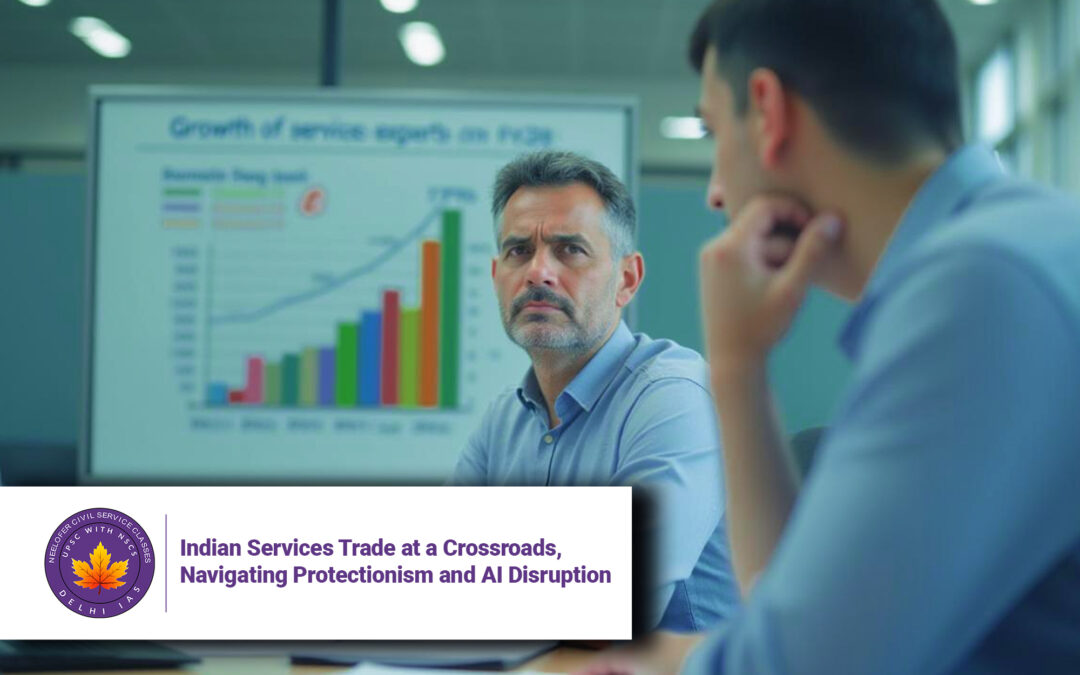Indian Services Trade at a Crossroads, Navigating Protectionism and AI Disruption
Introduction
While global attention remains fixated on tariff wars and goods trade, India’s burgeoning services exports—accounting for 44% of total exports ($300 billion in 2023-24)—face unprecedented challenges. The dual threats of rising protectionism in key markets and AI-driven job displacement demand urgent policy recalibration. This analysis examines:
-
India’s services export landscape and US dependence
-
Emerging barriers: Visa restrictions and AI disruption
-
Strategic responses to safeguard India’s “invisible trade”
-
5 Key Q&A on services trade future
India’s Services Trade: The Silent Powerhouse
1. Sectoral Composition (2023-24)
| Category | Share | Key Characteristics |
|---|---|---|
| IT/ITeS | 55% | $165 billion; 70% US-dependent |
| Engineering/R&D | 18% | Growing at 12% CAGR |
| Financial/Legal Services | 15% | Underpenetrated (5% global share) |
| Healthcare/Education | 12% | COVID-driven telehealth boom |
2. Unique Advantages
-
Cost Arbitrage: 30-40% cheaper than Western counterparts
-
English Proficiency: 2nd largest English-speaking workforce
-
GCC Ecosystem: 1,700+ centers employing 2 million
The Gathering Storm: Threats to Services Trade
1. Protectionist Barriers
-
US H-1B Visa Changes:
-
2023: 48% rejection rate (vs. 28% in 2022)
-
Minimum wage hike to $130,000 for certain categories
-
-
EU’s Digital Services Tax: 3% levy on Indian IT firms’ revenues
-
UK’s Immigration Caps: 40% cut in skilled worker visas
2. AI Disruption Timeline
| Timeframe | Impact Level | Vulnerable Sectors |
|---|---|---|
| 2024-2026 | 15-20% jobs | Basic coding, data entry |
| 2027-2030 | 30-45% jobs | Accounting, legal documentation |
| Post-2030 | 50%+ jobs | Radiology, financial analysis |
Source: NASSCOM AI Adoption Survey 2024
Strategic Responses: A Three-Pronged Approach
1. Diplomatic Measures
-
Bilateral Safeguards: Include services in ongoing US trade talks
-
WTO Coalition: Partner with Philippines, Nigeria on Mode 4 mobility
-
GCC Protection: Tax incentives for US firms retaining Indian centers
2. Industry Transformation
-
AI Integration Roadmap:
-
Tier 1 Firms: 30% R&D spend on AI/ML by 2026
-
SMEs: Govt-funded AI toolkits (₹500cr budget proposed)
-
-
Quality Certification:
-
ISO 56005 for innovation management
-
HIPAA-compliant healthcare BPOs
-
3. Domestic Policy Shifts
| Initiative | Target | Implementation |
|---|---|---|
| Services Export Promotion Council | 2025 launch | Combine IT, healthcare, legal verticals |
| National AI Registry | 50,000 certified professionals/year | IIT-led certification |
| Liberalization of Professional Sectors | 2026 deadline | Allow foreign law/accounting firms |
5 Key Q&A on India’s Services Trade
Q1: Why can’t India just shift services exports from US to other markets?
A: The US accounts for 60% of India’s IT exports due to:
-
Deep corporate relationships (30+ year history)
-
IP protection standards
-
Scale potential (India serves 75% of Fortune 500)
Q2: How real is the AI threat to Indian jobs?
A: NASSCOM estimates 40% of current IT jobs could be automated by 2030, but:
-
Net positive: AI could create 1 million new high-end jobs
-
Transition cost: $2 billion reskilling needed for 2.5 million workers
Q3: What’s the “Mode 4” controversy at WTO?
A: Mode 4 covers temporary movement of service providers (e.g., consultants). India demands:
-
Easier visa norms
-
Mutual recognition of qualifications
-
Currently blocked by US/EU over immigration concerns
Q4: Can GCCs (Global Capability Centers) absorb job losses?
A: Partially. GCCs employ 2 million but:
-
70% jobs are in routine operations (vulnerable to AI)
-
Only 30% in R&D/innovation (future-proof)
Q5: What lessons can India learn from Philippines’ services exports?
A: Their success in healthcare BPOs shows:
-
Niche specialization: Medical transcription
-
Cultural alignment: US-accent training
-
Policy support: 10-year tax holidays
Conclusion: From Cost Arbitrage to Value Arbitrage
India’s services sector must urgently pivot from its labor-cost advantage to knowledge-value leadership. This requires:
AI-first workforce strategy (reskill 5 million by 2030)
Geographic diversification (target EU, Japan, Africa)
Domestic deregulation (open legal/accounting sectors)
As R. Seshasayee warns, the window to act is narrowing. The choice is between becoming AI’s victims or its masters in global services trade. Policy makers must treat this with the same urgency as merchandise trade disputes—because in the digital age, services aren’t just exports; they’re strategic leverage.
Author
R. Seshasayee
Former Chairman, The Adyar Cancer Institute
Views are personal







